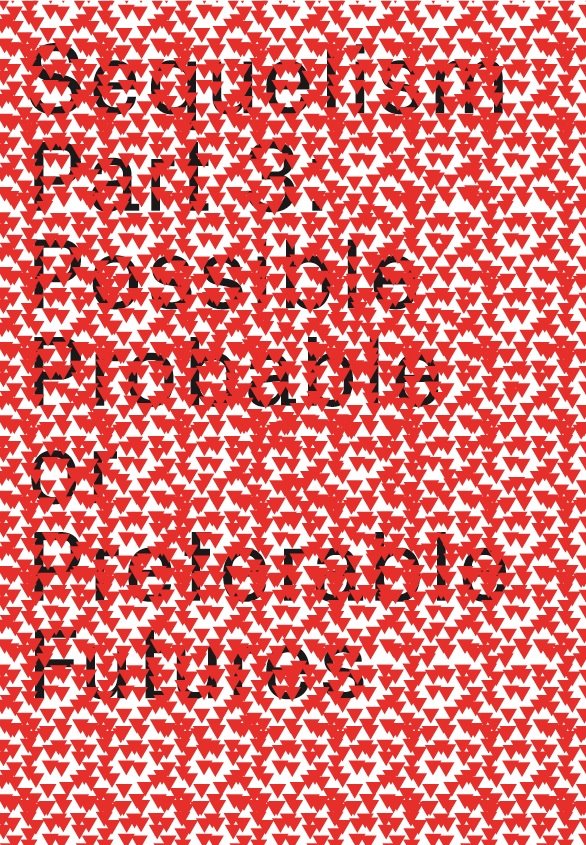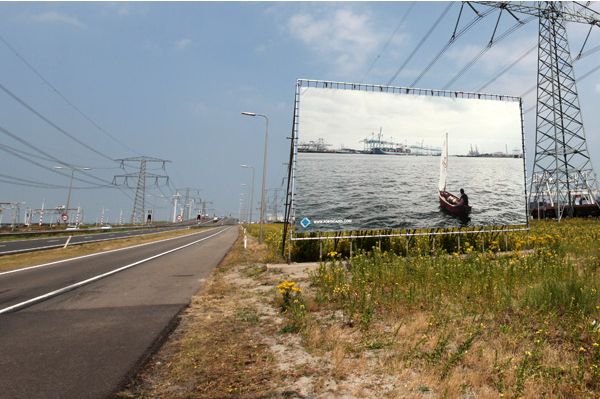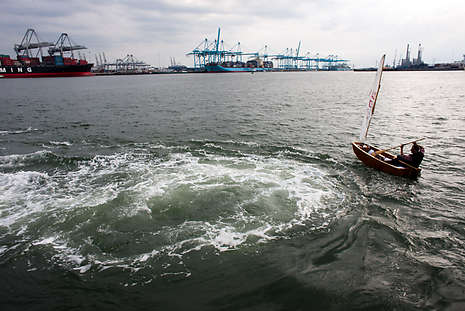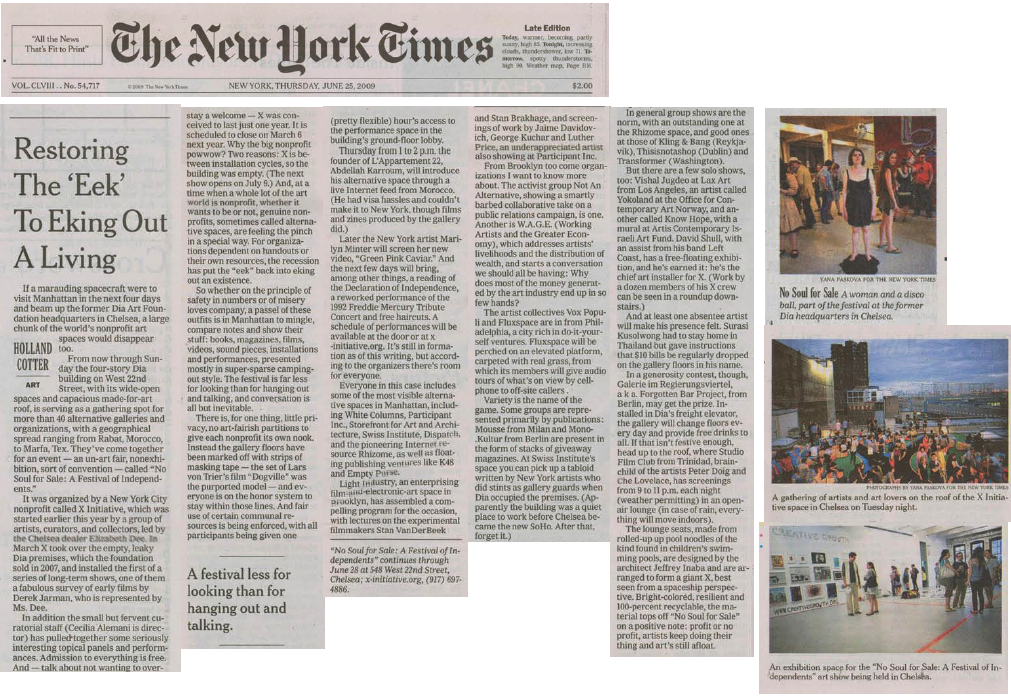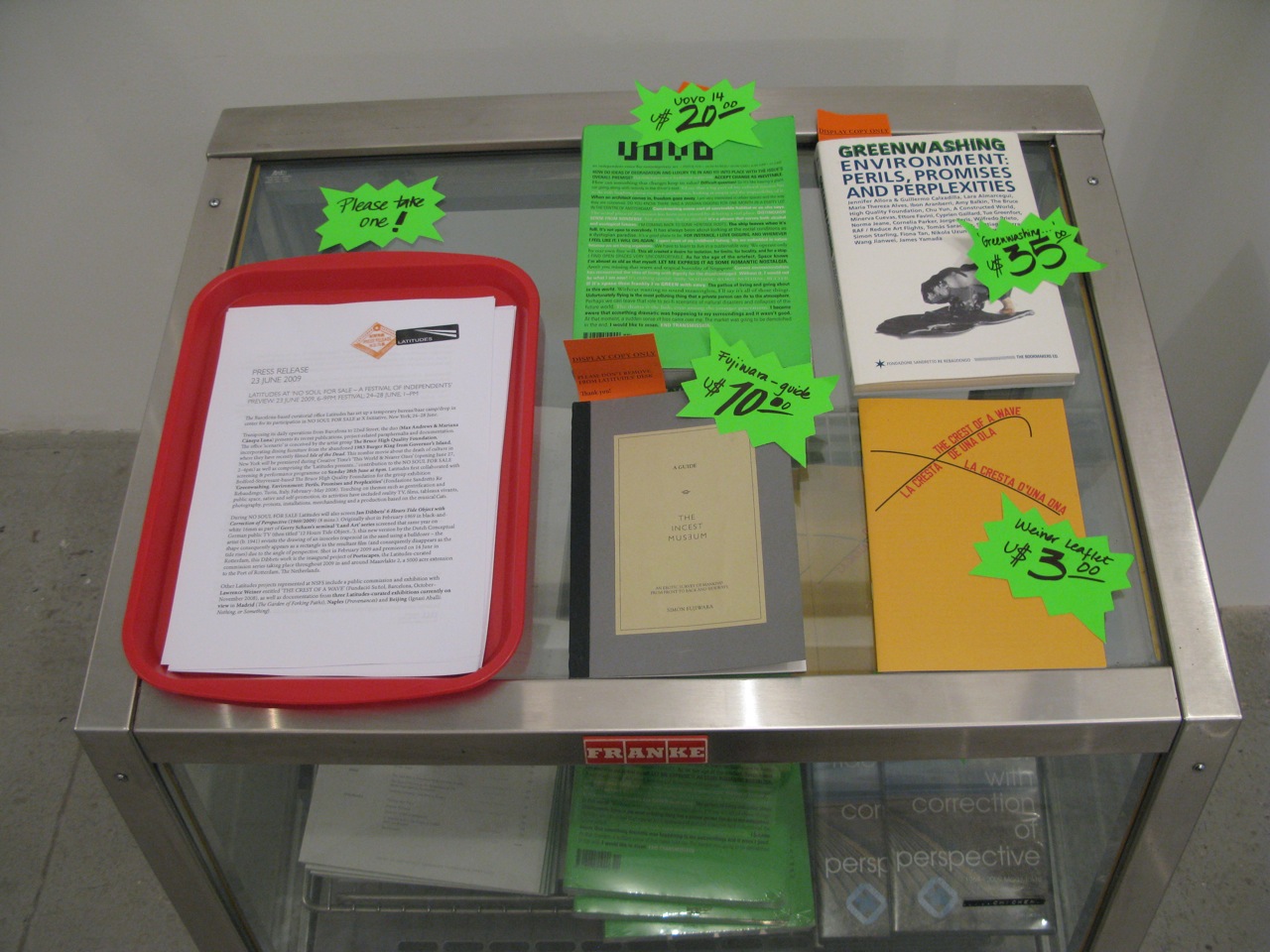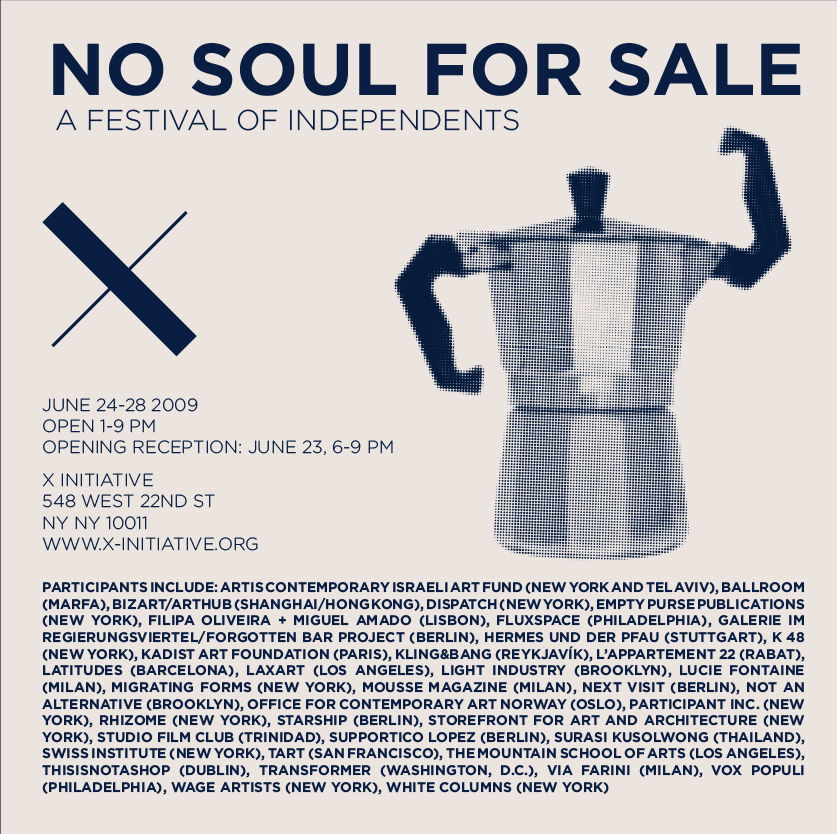SAVE THE DATE: Friday 17 July opening of 'Sequelism Part 3. Possible, Probable or Preferable Futures', Arnolfini, Bristol
Mon, Jul 6 2009
Invitation design to the exhibition with work by Heman Chong.
'Sequelism Part 3: Possible, Probable or Preferable Futures' (18 July–20 September 2009)
Preview: Friday 17 July, 6–8pm
Venue: Arnolfini, Bristol, UK
Venue: Arnolfini, Bristol, UK
Artists: Mariana Castillo Deball (1975, Mexico City. Lives in Berlin/Amsterdam), Heman Chong (1977, Malaysia. Lives in Berlin/Singapore), Graham Gussin (1960, London. Lives in London), Victor Man (1974, Cluj–Napoca. Lives in Cluj–Napoca), Francesc Ruiz (in residency) (1971 Barcelona. Lives in Barcelona/Berlin), Jordan Wolfson (1980, New York. Lives New York/Berlin) and Haegue Yang (1971 Seoul. Lives in Berlin/Seoul)
Co-curated by Arnolfini and Latitudes
'Sequelism Part 3: Possible, Probable or Preferable Futures' is a project that looks into the future and at that which is yet to happen. It considers how art and the inexact arena of futurology might be utilised as a means to better comprehend, rethink, obscure, or even colonise the present. Knowledge of current and historical events often plays a role in collective foresight or prognoses of change that is yet to take place. In a similar fashion, futurology could be said to deal with memory in reverse. The project seeks to investigate how prospective visions might be generated for vastly differing reasons, offering great idealism on the one hand, or harnessing political and societal anxiety on the other.
The future is commonly manifested in popular cultural forms, including science fiction, yet how might we look beyond the present without recourse to established genres? To what extent does strategic foresight affect our understanding of the ‘now’ or the ‘when’? Is the future a culturally specific phenomenon that is inherently ‘Western’ in its own gaze and orientation? And just how accurate can we be when imagining the future? The Sequelism project addresses issues and questions such as these. Disputing illustrative organisation around a predetermined thesis, the project itself invites doubt, speculation, and to-be-determined outcomes.
This is the first in a trilogy of Sequelism exhibitions, with Part 2 in 2010.
More information: http://futurologyprogramme.org
Events and screenings
Neil Cummings and Marysia Lewandowska
Museum Futures: Distributed
Screening/Discussion, Saturday 18 July, 2pm, Free
Neil Cummings and Marysia Lewandowska’s film 'Museum Futures: Distributed (2008) is a machinima record of the centenary interview with Moderna Museet’s executive Ayan
Lindquist in June 2058. It explores a possible genealogy for contemporary art practice and its institutions, by reimagining the role of artists, museums, galleries, markets, ‘manufactories’ and academies. The screening will also incorporate a discussion led by Neil Cummings and the curators of the Sequelism exhibition, discussing the future of art institutions.
The Futurological Congress
Sequelism Artists’ Screening Programme
Screening, Friday 21 August, 7.30pm, £3/£2 concs
A programme of artists’ videos selected by the curators of Sequelism to accompany the exhibition, including works by Marjolijn Dijkman, Jordan Wolfson and Julia Meltzer & David
Thorne. Introduced by Nav Haq, Exhibitions Curator, Arnolfini.
David Maljkovic
'Scene for a New Heritage Trilogy Screening'
Thursday 17 September, 6.30pm, Free
The films in David Maljkovic’s renowned 'Scene for a New Heritage Trilogy' (2004–6) are set between 2045 and 2071, visualising different encounters with a communist monument at the memorial park at Petrova Gora, Croatia, and speculating on how the meanings of history and monuments change over time.
Roy Ascott
Art and Technoetic Evolution: when the Mind outgrows the Body
Artist’s talk, Saturday 19 September, 2pm, Free
Artist and theorist Roy Ascott gives a presentation on the recent ideas informing his Technoetics art practice, that has grown out of his long-term research into cybernetic and ‘telematic’ art.
Will Holder
Neologisms Workshop
Workshop, September, date TBC, Free
Booking required, call 0117 917 2300 / 01
A language workshop for young people led by the designer, writer, and editor Will Holder for constructing brand new words or ‘neologisms’, inspired by R. Buckminster Fuller’s technique for synthesizing existing words to generate names for new concepts and designs.
–
Arnolfini
16 Narrow Quay
Bristol BS1 4QA, UK
www.arnolfini.org.uk
Opens: 10am-6pm Tues-Sun & Bank Holiday Mondays | Closed Mondays | Free entrance
Sequelism is possible thanks to the generous support of the State Corporations for Spanish Cultural Action Abroad (SEACEX), the Direction of Cultural and Scientific Relations of the Spanish Ministry of Foreign Affairs, Institute Ramon Llull, The National Arts Council Singapore and IFA.
Co-curated by Arnolfini and Latitudes
'Sequelism Part 3: Possible, Probable or Preferable Futures' is a project that looks into the future and at that which is yet to happen. It considers how art and the inexact arena of futurology might be utilised as a means to better comprehend, rethink, obscure, or even colonise the present. Knowledge of current and historical events often plays a role in collective foresight or prognoses of change that is yet to take place. In a similar fashion, futurology could be said to deal with memory in reverse. The project seeks to investigate how prospective visions might be generated for vastly differing reasons, offering great idealism on the one hand, or harnessing political and societal anxiety on the other.
The future is commonly manifested in popular cultural forms, including science fiction, yet how might we look beyond the present without recourse to established genres? To what extent does strategic foresight affect our understanding of the ‘now’ or the ‘when’? Is the future a culturally specific phenomenon that is inherently ‘Western’ in its own gaze and orientation? And just how accurate can we be when imagining the future? The Sequelism project addresses issues and questions such as these. Disputing illustrative organisation around a predetermined thesis, the project itself invites doubt, speculation, and to-be-determined outcomes.
This is the first in a trilogy of Sequelism exhibitions, with Part 2 in 2010.
More information: http://futurologyprogramme.org
Events and screenings
Neil Cummings and Marysia Lewandowska
Museum Futures: Distributed
Screening/Discussion, Saturday 18 July, 2pm, Free
Neil Cummings and Marysia Lewandowska’s film 'Museum Futures: Distributed (2008) is a machinima record of the centenary interview with Moderna Museet’s executive Ayan
Lindquist in June 2058. It explores a possible genealogy for contemporary art practice and its institutions, by reimagining the role of artists, museums, galleries, markets, ‘manufactories’ and academies. The screening will also incorporate a discussion led by Neil Cummings and the curators of the Sequelism exhibition, discussing the future of art institutions.
The Futurological Congress
Sequelism Artists’ Screening Programme
Screening, Friday 21 August, 7.30pm, £3/£2 concs
A programme of artists’ videos selected by the curators of Sequelism to accompany the exhibition, including works by Marjolijn Dijkman, Jordan Wolfson and Julia Meltzer & David
Thorne. Introduced by Nav Haq, Exhibitions Curator, Arnolfini.
David Maljkovic
'Scene for a New Heritage Trilogy Screening'
Thursday 17 September, 6.30pm, Free
The films in David Maljkovic’s renowned 'Scene for a New Heritage Trilogy' (2004–6) are set between 2045 and 2071, visualising different encounters with a communist monument at the memorial park at Petrova Gora, Croatia, and speculating on how the meanings of history and monuments change over time.
Roy Ascott
Art and Technoetic Evolution: when the Mind outgrows the Body
Artist’s talk, Saturday 19 September, 2pm, Free
Artist and theorist Roy Ascott gives a presentation on the recent ideas informing his Technoetics art practice, that has grown out of his long-term research into cybernetic and ‘telematic’ art.
Will Holder
Neologisms Workshop
Workshop, September, date TBC, Free
Booking required, call 0117 917 2300 / 01
A language workshop for young people led by the designer, writer, and editor Will Holder for constructing brand new words or ‘neologisms’, inspired by R. Buckminster Fuller’s technique for synthesizing existing words to generate names for new concepts and designs.
–
Arnolfini
16 Narrow Quay
Bristol BS1 4QA, UK
www.arnolfini.org.uk
Opens: 10am-6pm Tues-Sun & Bank Holiday Mondays | Closed Mondays | Free entrance
Sequelism is possible thanks to the generous support of the State Corporations for Spanish Cultural Action Abroad (SEACEX), the Direction of Cultural and Scientific Relations of the Spanish Ministry of Foreign Affairs, Institute Ramon Llull, The National Arts Council Singapore and IFA.
Newsletter #14, July 2009
Fri, Jul 3 2009We have just circulated our newsletter #14 (read English version or Versión española).
In July we are presenting Hans Schabus' 'Europahaven, Rotterdam, 17 Juni 2009' (see above) at the visitor centre Futureland (until 15 August) and concluded the screenings of Jan Dibbets' film '6 Hours Tide Object with Correction of Perspective', which will soon be available on Portscapes' website (www.portscapes.com).
We are also curating the group exhibition 'Sequelism. Part 3: Possible, Probable, or Preferable Futures', Arnolfini, Bristol, UK, opening 17 July (remains on view until 20 September). Part 3 includes works by Mariana Castillo Deball (1975, Mexico City. Lives in Berlin/Amsterdam), Heman Chong (1977, Malaysia. Lives in Berlin/Singapore), Graham Gussin (1960, London. Lives in London), Victor Man (1974, Cluj–Napoca. Lives in Cluj–Napoca), Francesc Ruiz (in residency) (1971 Barcelona. Lives in Barcelona/Berlin), Jordan Wolfson (1980, New York. Lives New York/Berlin) and Haegue Yang (1971 Seoul. Lives in Berlin/Seoul). Read more about the events programme here.
We also published installation images and press links related to Latitudes' recent participation in the festival of independent and non-profit art organisations 'NO SOUL FOR SALE – A Festival of Independents' organised by X initiative in New York (24–28 June 2009) where we had an office ‘scenario’ conceived by the artist group The Bruce High Quality Foundation, incorporating dining furniture from the abandoned 1983 Burger King from Governors Island.
This month is the last chance to visit the exhibitions 'The Garden of Forking Paths' (Maisterravalbuena, Madrid, until 18th July, images here) and 'Nothing, or Something' (a new project by Ignasi Aballí for Suitcase Art Projects, Beijing, China, until 22nd July, images here).
If you would like to subscribe to our mailing list please fill your data on this contact form (see left) and choose one language. If you would like to read previous newsletters or annoucements, click here.
You can also join us on facebook.
Hans Schabus project for 'Portscapes': 'Europahaven, Port of Rotterdam, 17 Juni 2009'
Fri, Jul 3 2009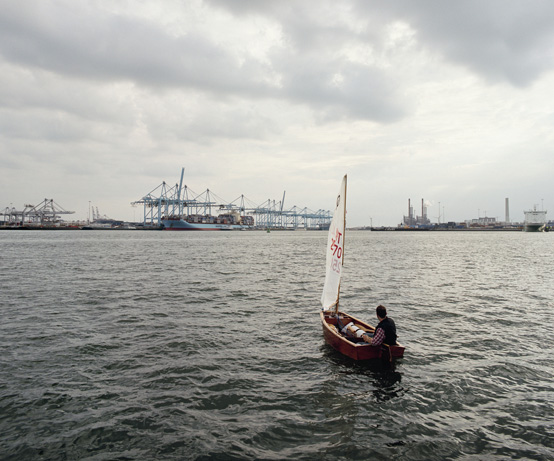 |
| Hans Schabus, 'Europahaven, Rotterdam, 17 Juni 2009' produced in the context of Portscapes commission series. Photo: Freek van Arkel. |
Hans Schabus’ project for Portscapes is the next chapter in his ongoing series of ‘arrival photographs’ featuring the sailing boat Forlorn. The artist has produced a new photograph which can be seen on a roadside 5 x 9 metre billboard on the A15 (1km before reaching the visitor centre Futureland -- satellite view here), and is also distributed as a postcard. A presentation of Forlorn, the film ‘Western’ (2002), a series of photographs and the postcard will be on view at Futureland (directions and opening hours below) until 15 August 2009, a presentation that has been conceived in collaboration with the artist to give further insight into the context of this extraordinary image – below a photo of the billboard presentation followed by production shots.
The Forlorn (2002) is a wooden-hulled ‘Optimist’ class sailing dinghy designed for a crew of one; in fact it is intended for children. The project of the ‘arrival photographs’ started with Western (2002), a film in which we see Schabus navigating through the sewers of his native Vienna in the self-built boat. He paddles through several sewage tracts until reaching a canal, a one way trip through a sinister labyrinth, a dark and obscure underground world. The film makes reference to Orson Welles’ 1949 film The Third Man through the use of the original score – at the film’s climax, Harry Lime flees from the authorities through the same sewers.
Hans Schabus’ (1970 Watschig, Austria. Lives in Vienna, Austria) sculptures and interventions often refer directly to his mental and physical surroundings, particularly to his studio and also by exploring excavation, transportation and engineering. His work embraces ecological cycles of construction, destruction and renewal – elements that were present in the 2004 exhibition at Kunsthaus Bregenz, where the artist transformed the entire building into a complex and convoluted architectonic and mental path of discovery. The show included large-scale videos of train journeys to visit the venue during preparations, as well as flooding the ground floor and encompassing an imaginary tunnel to the basement of the building. In 2006 he produced the ‘Book of Ballast’ in which he explored a mostly forgotten sea connection between Liverpool and the US city of Savannah. Schabus documented numerous stones which made their way as ballast on ships to ports on the east coast of America, where they were put to use to pave streets and build houses. The artist became more widely known when he represented Austria at the 2005 Venice Biennale with the project The Last Land, whereby he created a maze inside a ‘mountain’ that completely covered the pavilion building.
Schabus’ solo projects include: Next Time I’m Here, I’ll Be There, The Curve, Barbican Gallery, London (2008); Deserted Conquest, SITE Santa Fe, New Mexico (2007); Kasseler Kunstverein, Kassel, Germany (2006); Kunsthaus Bregenz, Bregenz, Austria (2004); and Secession, Vienna, Austria (1996 and 2003). Group exhibitions include: Revolutions – Forms That Turn, Biennale of Sydney (2008); Turin Triennial (2005); and Manifesta 4, Frankfurt (2004).
Postcard produced for 'Portscapes'. See image gallery here.
–
Futureland is on the edge of the current Maasvlakte along the extension of the A15. It is across the road from the E.ON power plant. The information center is open from Tuesday–Friday (10am-5pm) and on Sunday (11am-5pm). Free entrance.
'Portscapes' is a series of newly commissioned public projects taking place alongside the construction of Maasvlakte 2 – the extension to the Port of Rotterdam. www.portscapes.nl
An initiative of the Port of Rotterdam Authority with advice from SKOR (Foundation for Art and Public Space). Curated by Latitudes, www.LTTDS.org
–
Futureland is on the edge of the current Maasvlakte along the extension of the A15. It is across the road from the E.ON power plant. The information center is open from Tuesday–Friday (10am-5pm) and on Sunday (11am-5pm). Free entrance.
'Portscapes' is a series of newly commissioned public projects taking place alongside the construction of Maasvlakte 2 – the extension to the Port of Rotterdam. www.portscapes.nl
An initiative of the Port of Rotterdam Authority with advice from SKOR (Foundation for Art and Public Space). Curated by Latitudes, www.LTTDS.org
Jornadas entorno al Canòdrom, el futuro Centro de Arte en Barcelona, 6–7 Julio 2009
Fri, Jul 3 2009Los próximos 6 y 7 de julio tendrá lugar en el Auditorio del MACBA (Plaça Joan Coromines, s/n) las 'Jornadas Internacionales de Debate para un Nuevo Centro de Arte en Barcelona' - programa a continuación.
Latitudes participará en la mesa redonda 'El Canòdrom, un nuevo equipamiento en Barcelona visto por artistas, críticos y comisarios' que tendrá lugar el Lunes 6 Julio, 18–20h, seguido por un debate de 20–21h – véanse notas de nuestra presentación.
Entrada gratuita – Plazas limitadas – Inscripción previa (hasta el 4 Julio) a nuriagregori@yahoo.es o llamando al 676 135 250
Organiza: Consell Nacional de la Cultura i de les Arts, Departament de Cultura i Mitjans de Comunicació, Ajuntament de Barcelona, Consell de la Cultura de Barcelona.
–
Programa CANÒDROM’09. Jornadas internacionales de debate para un nuevo Centro de Arte en Barcelona
Desde la proliferación de centros de arte en Europa a principios de los años 80 hasta la actualidad, el concepto de centro de arte se ha modificado y ha evolucionado, siguiendo patrones distintos adaptados a cada contexto y a la evolución de la tecnología y de la comunicación, así como a la convivencia con la industria cultural, al carácter multidisciplinar del arte, a las nuevas prácticas curatoriales, al ejercicio de la mediación social y a la labor educativa y de formación en el marco de una sociedad global.
Con el fin de dar impulso al nuevo proyecto del futuro Centro de Arte Contemporáneo de Barcelona, con sede en el edificio del Canòdrom de la Meridiana de Barcelona, se organizan unas jornadas internacionales de debate y discusión que cuentan con la participación de los directores de varios centros de arte europeos ejemplos de diversos de los modelos existentes. Asimismo se hace un llamamiento al sector de las artes visuales —artistas, críticos, comisarios, galeristas, estudiantes de arte, gestores culturales y demás agentes y emprendedores artísticos— para que formen parte de este debate.
Lunes, 6 de julio
Mañana 10.00 h – 10.30 h
Apertura de las jornadas a cargo de Pilar Parcerisas, Vicepresidenta Primera del Consejo Nacional de la Cultura y de las Artes, y Daniel Giralt-Miracle, miembro del Comité Ejecutivo del Consejo de la Cultura de Barcelona.
10.30 h – 12.00 h
El Canòdrom, un edificio para el arte contemporáneo Xavier Monteys y Josep M. de Lecea, arquitectos. Autores de la restauración y remodelación del Canòdrom
12.00 h – 12.30 h Pausa
12.30 h - 14.00 h
Los centros de arte en Europa, hoy. Especificidad y límites frente a los museos.
Dirk Snauwaert, Director del Centro de Arte Contemporáneo Wiels, Bruselas
Nicolaus Schafhausen, Director de Witte de With, Rotterdam
Modera: Roberta Bosco, periodista de arte de El País, Barcelona
14.00 h - 14.30 h Debate
16.00 h - 17.30 h
El modelo inglés y su relación con los consejos de las artes. La tradición de la Cornerhouse.
Dave Moutrey, Director de la Cornerhouse, Manchester
17.30 h - 18.00 h Pausa
18.00 h - 20.00 h
El Canòdrom, un nuevo equipamiento en Barcelona visto por artistas, críticos y comisarios.
Carles Guerra, Director de La Virreina. Centro de la imagen, Barcelona
Amanda Cuesta, crítica de arte y curadora de exposiciones
Jorge Luis Marzo, miembro del grupo de debate Centro de Arte Barcelona
Latitudes (Max Andrews y Mariana Cánepa), curadores independientes
Joan Fontcuberta, artista y Presidente de la Asociación de Artistas Visuales de Cataluña (AAVC)
Daniel García Andújar, artista y presidente de la Asociación de Artistas Visuales de Cataluña (AAVC)
Modera: Mercè Alsina, crítica de arte y curadora de exposiciones, Secretaria de la Asociación Catalana de Críticos de Arte (ACCA)
20.00 h – 21.00 h Debate
Martes, 7 de julio
10.00 h - 11.30 h
El flujo del arte contemporáneo en los centros de arte: producción, presentación, difusión
Bartomeu Marí, ex Director de Witte de With y actualmente Director del Macba, Barcelona
11.30 h - 12.00 h Pausa
12.00 - 14.00 h
En red. El Canòdrom desde el territorio.
Oriol Gual, Director del espacio La Capella, Barcelona
David Santaeulària, Director del espacio Zero 1, Olot
Glòria Picazo, Directora del Centro de Arte La Panera, Lleida.
Rosa Pera, Directora de Bòlit, Centro de Arte, Girona
Anna Capella, Directora del Museo del Ampurdán, Figueres
Jordi Abelló, Coordinador de los espacios de arte del Ayuntamiento de Tarragona
Víctor Sunyol, Presidente de H. Asociación para las Artes Contemporáneas, Vic
Clara Garí, Directora de la Nau Côclea, Camallera
Modera: Oriol Picas, Subdirector General de Equipamientos del Departamento de Cultura y Medios de Comunicación de la Generalidad de Cataluña.
14.00 h - 14.30 h Debate 16.00 h - 17.30 h
Los retos de futuro de los centros de arte
Susanne Pfeffer, Curadora del KW Instituto de Arte Contemporáneo, Berlín
Kestutis Kuizinas, Director del Centro de Arte Contemporáneo (CCA), Vilnius, Lituania
Francis McKee, Director del Centro de Arte Contemporáneo, Glasgow
Laurence Rassel, Directora de proyectos de la Fundación Antoni Tàpies, Barcelona
Modera: Rosario Fontova, periodista de arte independiente, Barcelona
17.30 h - 18.00 h Pausa
18.00 h - 20.00 h
Espacios de producción y creación con relación al Canòdrom
Víctor Lobo, co-director de Experimentem amb l’art, Barcelona
Pep Dardanyà, director de Can Xalant, Mataró
Tere Badia, investigadora y coordinadora de Xarxaprod
Pedro Soler, director de Hangar, Barcelona
Sergi Díaz, coordinador de Fabra i Coats, Barcelona
Modera: Ramon Parramon, director de Idensitat y jefe de estudios de posgrado de Elisava
Cierre de las jornadas a cargo de Lluís Noguera, Secretario General del Departamento de Cultura y Medios de Comunicación de la Generalidad de Cataluña, y Jordi Martí, Delegado de Cultura del Ayuntamiento de Barcelona.
CONTENIDO RELACIONADO:
Notas presentación de Latitudes expuestas durante las "Jornadas internacionales de debate para El Canòdrom, el nuevo Centro de Arte en Barcelona", 6–7 Julio 2009 (10 julio 2009)
'NO SOUL FOR SALE': Press Coverage
Wed, Jul 1 2009Following is a selection press articles, blogs, announcements and slideshows links related to 'NO SOUL FOR SALE – A Festival of Independents' which took place between 24–28th June in New York (if we missed any materials, please do share the link with us!).
p.s. Some sources are confused about the nature of Latitudes' space in the festival. Just to clarify, we didn't built a faux Burger King, the 'scenario' – assembled entirely thanks to The Bruce High Quality Foundation – comprised real dining furniture from the abandoned 1983 Burger King from Governors Island (see photo-documentation of the original site taken by two photographers invited in 2003 by Public Art Fund – images 2 and 3 of the slideshow).
e-Flux, June 15, 2009
http://www.e-flux.com/shows/view/6898
Holland Cotter, 'Restoring the ‘Eek’ to Eking Out a Living', New York Times, 24 June 2009
http://www.nytimes.com/2009/06/25/arts/design/25soul.html?_r=1&scp=1&sq=restoring%20the%20eek&st=cse
and slideshow here http://www.nytimes.com/slideshow/2009/06/24/arts 20090625_SOUL_SLIDESHOW_index.html
Jerry Saltz, 'Saltz: Glimpse Art’s Near Future at No Soul for Sale', 24 June 2009
http://nymag.com/daily/entertainment/2009/06/saltz_glimpse_arts_near-future.html
Laura Meli, 'The Anti-commerce, Pro-art “No Soul for Sale” Festival', 25 June 2009
http://www.nyartbeat.com/nyablog/2009/06/the-anti-commerce-pro-art-no-soul-for-sale-festival
Time Out Art, 25 June 2009
http://www3.timeoutny.com/newyork/tonyblog/2009/06/no-soul-for-sale-at-x-initiative
William Pym, Artforum Scene & Heard, 'Whatever Works', 26 June 2009
http://www.artforum.com/diary/#entry23170 (text)
http://www.artforum.com/diary/id=23170#readon23170 (more images)
Sunday, 28 June, 2009 (images)
http://www.16miles.com/2009/06/no-soul-for-sale-festival-of.html
23 June 2009, www.designboom.com
http://www.designboom.com/weblog/cat/10/view/6793/no-soul-for-sale.html
Ceci Moss, 'Dispatches from No Soul For Sale: More Highlights!', 29 June 2009
http://rhizome.org/editorial/2732
Materials presented at 'NO SOUL FOR SALE'
Thu, Jun 25 2009During 'NO SOUL FOR SALE' we are presenting several publications and paraphernalia related to our projects, including:
– Compendium of essays, artists' projects, etc. 'Land, Art: A Cultural Ecology Handbook' (Royal Society of Arts/Arts Council England, 2006)
– Magazine UOVO #14 'Ecology, Luxury and Degradation' (The Bookmakers Ed., Summer 2007)
– Exhibition catalogue 'Greenwashing. Environment: Perils, Promises and Perplexities' (The Bookmakers Ed., February 2008)
– Artist book by Simon Fujiwara 'The Museum of Incest: A Guide' (Archive Books, May 2009)
We also have DVDs of Jan Dibbets' recent film '6 Hours of Tide Object with Correction of Perspective' (as part of Portscapes) and a public sculpture produced in October 2008 by Lawrence Weiner on occasion of his exhibition 'THE CREST OF A WAVE' at Fundació Suñol, Barcelona (we also have the exhibition booklet available).
The Bruce High Quality Foundation also have a computer available from where visitors can burn DVDs for $5 as well as some of their publications.
Latitudes' temporary office in 'NO SOUL FOR SALE' with a 'scenario' by The Bruce High Quality Foundation
Wed, Jun 24 2009Transposing our daily operations from Barcelona to New York's 22nd Street, Latitudes is presenting its recent publications, project-related paraphernalia and documentation. The office ‘scenario’ is conceived by the artist group The Bruce High Quality Foundation, incorporating dining furniture from the abandoned 1983 Burger King from Governor’s Island (see images above and below), where they have recently filmed 'Isle of the Dead'. This zombie movie about the death of culture in New York will be premiered during Creative Time’s ‘This World & Nearer Ones’ (opening June 27,2–4pm). Latitudes first collaborated with Bedford-Stuyvesant-based The Bruce High Quality Foundation for the group exhibition ‘Greenwashing. Environment: Perils, Promises and Perplexities’ (Fondazione Sandretto Re Rebaudengo, Turin, Italy, February–May 2008). Touching on themes such as gentrification and public space, satire and self-promotion, its activities have included reality TV, films, tableaux vivants, photography, protests, installations, merchandising and a production based on the musical Cats.
During NO SOUL FOR SALE we are also showing Jan Dibbets’ 6 Hours Tide Object with
Correction of Perspective (1969/2009) (8 mins.) as well as the 'making of' the film (20 mins). Shot in February 2009 and premiered on 14 June in Rotterdam, this Dibbets work is the inaugural project of Portscapes, the Latitudes-curated commission series taking place throughout 2009 in and around Maasvlakte 2, a 5000 acre extension to the Port of Rotterdam, The Netherlands.
NO SOUL FOR SALE: 24–28 June, 1–9pm. Free admission.
28 June, 6–7pm: Screening three films by The Bruce High Quality Foundation
X INITIATIVE: 548 West 22nd Street, New York, NY 10011 (former Dia Center)
GETTING THERE: C or E train to West 23 Street station, and walk west on 22nd towards X
All images: Latitudes | www.lttds.org
Participation in 'NO SOUL FOR SALE – A Festival of Independents', New York, 24–28 June
Sun, Jun 14 2009Latitudes will be soon participating in 'NO SOUL FOR SALE – A Festival of Independents' (24–28 June, 1–9pm, free entrance) an event hosted by X initiative which will bring together 38 not-for-profit centers, alternative institutions, artists’ collectives and independent enterprises from Berlin, Milan, Dublin, Lisbon, Paris, Reykjavík, Hong Kong, Rabat, Trinidad, New York, Los Angeles, etc. that contribute to the international art scene by generating a diverse cultural programme.
Latitudes will set up a temporary office-base camp, transposing our daily operations while presenting our publications (exhibition catalogues, guest-edited magazines, artist books and anthologies) and other paraphernalia. The office-scenario' will be conceived by the artist group The Bruce High Quality Foundation, incorporating dining furniture from the abandoned Burger King facility on Governor's Island, where they have recently shot 'Isle of the Dead', a zombie movie to be premiered in Fort Jay Theater during Creative Time’s 'This World & Nearer Ones' (opening June 27, 2–4pm) as well as in the X Initiative screening & performing area on Sunday 28th from 6pm.
During 'NO SOUL FOR SALE' Latitudes will also premiere the 8 minute film '6 Hours Tide Object with Correction of Perspective', the new version of a 1969 film by Dutch Conceptual artist Jan Dibbets (1941) and the inaugural project of Portscapes, the public commission series taking place throughout 2009 in and around Maasvlate 2, the 2,000 hectare extension to the Port of Rotterdam.
Participants: Artis Contemporary Israeli Art Fund (New York and Tel Aviv), Ballroom (Marfa), BizArt/Arthub (Shanghai/Hong Kong), DISPATCH (New York), Empty Purse Publications (New York), Filipa Oliveira + Miguel Amado (Lisbon), FLUXspace (Philadelphia), Galerie im Regierungsviertel / Forgotten Bar Project (Berlin), Hermes und der Pfau (Stuttgart), K 48 (New York), Kadist Art Foundation (Paris), Kling&Bang (Reykjavík), L’Appartement 22 (Rabat), Latitudes (Barcelona), LAXART (Los Angeles), Light Industry (Brooklyn), Lucie Fontaine (Milan), Migrating Forms (New York), Mousse Magazine (Milan), Next Visit (Berlin), Not An Alternative (Brooklyn), Office for Contemporary Art Norway (Oslo), Participant Inc. (New York), Rhizome (New York), STARSHIP (Berlin), Storefront for Art and Architecture (New York), Studio Film Club (Trinidad), Supportico Lopez (Berlin), Surasi Kusolwong (Thailand), Swiss Institute (New York), TART (San Francisco), The Mountain School of Arts (Los Angeles), Thisisnotashop (Dublin), Transformer (Washington, D.C.), Via Farini (Milan), Vox Populi (Philadelphia), WAGE Artists (New York), White Columns (New York).
Latitudes' participation is partly supported by the Institut Ramon Llull.
–
X INITIATIVE, 548 West 22nd Street (former Dia Center), New York, NY 10011, USA [MAP HERE]Opening Reception: June 23, 6-9 pm with a performance by Martin Soto Climent.
Opening Hours: June 24–28 2009, 1–9 pm. FREE ENTRANCE
Overview of the 53rd International Art Exhibition, Venice Biennial: 'Making Worlds // Fare Mondi'
Sun, Jun 14 2009Daniel Birnbaum's 'Making Worlds' felt less melancholic though still very much in keeping with his recently-curated '50 Moons of Saturn', the 2nd Turin Triennial (see post 10 November 2008). Both exhibitions shared several artists (Ulla von Brandenburg, Koo Jeong-A, Pietro Roccasalva, Spencer Finch, Ceal Floyer, Lara Favaretto, Pascale Marthine Tayou, Haegue Yang, Paul Chan, Tomás Saraceno, Wade Guyton, Keren Cytter and Rosa Barba), while Venice included several students (including Att Poomtangon) or professors (Simon Starling, Wolfgang Tillmans) from the Birnbaum-directed Staedelschule in Frankfurt, and the support of curator Jochen Volz in the artistic organisation (additional advice was provided by a team of 'correspondents': Savita Apte, Tom Eccles, Hu Fang and Maria Finders). In contrast with the 2007 biennial by Robert Storr it felt less painterly and more sculptural and with a notable lack of 'black boxes' with film and video work.
There seemed to be however, a certain self-reflexivity with regard to the biennale context: several works referred to the winter life of the Giardini venues (Steve McQueen's film in the British Pavilion; Haegue Yang's video in the Korean Pavilion) and the challenge artists face when asked to present work for this type of event. This was most evident in Dominique Gonzalez-Foerster's video in the Palazzo delle Esposizioni (formerly named 'Padiglione Italia'), a touching exorcism of artistic exhaustion. During the last twenty years she has been asked to participate in the Biennale not less than five times, and she speaks about the pressure of expectation in creating something new every time.
Elsewhere in Venice the Biennial threatened to be overshadowed by the opening of François Pinault’s über-collection hosted in the recently renovated Punta della Dogana (the former customs house). The spectacular triangular building has undergone a speedy renovation by Japanese architect Tadao Ando (see video here) and the inaugural exhibition's sombre atmosphere is much in contrast to the über-kitch displays at Palazzo Grassi.
Without trying to be at all comprehensive (with almost one million square feet of exhibition space, more than ninety artists, seventy-seven national contributions, forty-four collateral events that seem increasingly impossible) here are some highlights in no particular order of the Giardini (see first slideshow with 107 images) and Arsenale (slideshow above with 52 images):
Roman Ondák’s 'Loop' contribution in the Czech/Slovak pavilion: a walk-through pavilion with a path running from the entrance to the back door that has been landscaped with exactly the same greenery that exists in the Giardini – it was executed with such precision that some visitors asked the artist if his work was the pavilion building itself as they could not find the 'art' anywhere.
Haegue Yang's 'Condensation' (Korea Pavilion) atmospheric assemblage of Venetian blinds, lamps or bulbs, scent atomizers, infrared motion detectors and crochet.
'The Collectors' in the Nordic and Danish pavilions, taken over by artists invited by Michael Elmgreen and Ingar Dragset which included exquisit works by Pepe Espaliú's ('Carrying Project') and Simon Fujiwara.
Lara Favaretto's 'Momentary Monument (Swamp)' at the Giardini delle Vergini as well as the three minute man-horse-motorbike film by David Bestué & Marc Vives, which together with their 'Acciones en casa' presented in the Arsenale, gave one of the only humorous notes in the exhibition.
Finally the biennial at last has a decent cafeteria! Tobias Rehberger was given the Golden Lion for the Best Artist for his neo-pop environment. It could well have been recognised along with another new facility previously in dire need of a revamp: the bookstore, which was designed by Rirkrit Tiravanija and hosted a comprehensive collection of monographs and catalogues.
Off-Giardini (Eventi Collaterali) highlights
(slideshow above with 33 images):
Joao Maria Gusmao & Pedro Paiva's 'Experiments and Observations on Different Kinds of Air' (Portugal) which included five 16mm films, a mixture of humour and magical realism (a sunset with three suns, a man lifting a bucket filled with water by grasping the water...). Truly great.
Teresa Margolles (Mexico) showing 'What else can we talk about?'. An traumatised and almost empty Palazzo Rota Ivancich highlighted the many Mexicans who have recently died in a violent manner. Margolles and her collaborators gathered blankets with blood and mud where victims fell. That mud and that same blood is slowly moistened in the ground floor and later used to mop the main floor. A decadent palazzo in almost complete silence combines personal dramas and national sorrow. As the artist put it 'we live in a country that cries' (La Jornada, 10 June). This, perhaps alongside Taiwan ('Foreign Affairs'), was by far the most self-critical national representation.
At Isola di Certosa: 'Animated Scene' by Irish artist John Gerrard: an amazing three-screen real time computer-generated projection of the American West: a reconstruction of a 1935 Texas dust storm, a year in the life of an automated pig production facility in the Great Sothern Plains and a man blacking out the facade of a white silo in Kansas – see images here.
Disappointments:
The Golden Lion for Best National Participation going to Bruce Nauman's 'Topological Gardens'. Yes, indeed a great artist but partly agreeing with Harry Bellet and Philippe Dagen from Le Monde: 'a retrospective without any new work is far away from the very principle of the Biennale: to reveal the present'. It also presented very familiar work from the 1960s until today from museums and private collections. His presentation did however come more to life in IUAV Tolentini and Ca'Foscari yet the need to cram three venues seems questionable.
Steve McQueen's ticketed entry to the British pavilion, showing a double-screen film portraying the off-season of the Giardini during the winter months: insects silently making their way through the vegetation, rain drops, Venetian bells ringing in the mist, greyhounds scavenging a trash-scattered Giardini, gay cruising in the small hours of the night. One cannot argue against the evident beauty of the piece, yet its impact quickly wore off.
Miquel Barceló representing Spain: not only because the choice of the project didn't follow any semblance of a democratic or juried selection (as did the Catalan Pavilion) but also the frankly flatfooted delivery: a hagiographic mini-retrospective complete with reading area.
Italian Pavilion in the Arsenale curated by Luca Beatrice and Beatrice Buscaroli: an embarrassingly poor exhibition, doing no justice to the tremendous artistic talent in the host country.
The sudden cancellation of Emily Jacir's project 'Stazione' for the Palestinian Pavilion (to display the names of each vaporetto station along the Grand Canal in Arabic alongside the Italian). It would have been a telling reference to the cross-cultural exchange between Venice and the Arab world and a great addition to the very little public-space work produced for this Biennale.
'In-Finitum' at the Palazzo Fortuny included some great works (include those by Anselmo, and a room with Lucio Fontana) although the exhibition felt much less compelling than 2007's 'Artempo: Where time becomes art'. This year it seems to include more 1950s-1970s work, more monochromes (Gutai group, Antoni Tàpies, Robert Ryman, James Turrell, Mark Rothko, Hiroshi Sugimoto...) and did not exactly run with the concept of 'the infinite'. The strength of this curatorial exercise lies in widening the timeframe while building a link between Fortuny's legacy and 'anonymous' work (e.g. Egyptian ancient sculpture) with contemporary works (on this occasion John Gerrard, Michael Borremans, Berlinde Bruyckere et. al.), which failed to spark this time.
–
53rd International Art Exhibition: Making Worlds // Fare Mondi // Bantin Duniyan // Weltenmachen // Construire des Mondes // Fazer Mundos…
Artistic director: Daniel Birnbaum
Giardini della Biennale / Arsenale
Without trying to be at all comprehensive (with almost one million square feet of exhibition space, more than ninety artists, seventy-seven national contributions, forty-four collateral events that seem increasingly impossible) here are some highlights in no particular order of the Giardini (see first slideshow with 107 images) and Arsenale (slideshow above with 52 images):
Roman Ondák’s 'Loop' contribution in the Czech/Slovak pavilion: a walk-through pavilion with a path running from the entrance to the back door that has been landscaped with exactly the same greenery that exists in the Giardini – it was executed with such precision that some visitors asked the artist if his work was the pavilion building itself as they could not find the 'art' anywhere.
Haegue Yang's 'Condensation' (Korea Pavilion) atmospheric assemblage of Venetian blinds, lamps or bulbs, scent atomizers, infrared motion detectors and crochet.
'The Collectors' in the Nordic and Danish pavilions, taken over by artists invited by Michael Elmgreen and Ingar Dragset which included exquisit works by Pepe Espaliú's ('Carrying Project') and Simon Fujiwara.
Lara Favaretto's 'Momentary Monument (Swamp)' at the Giardini delle Vergini as well as the three minute man-horse-motorbike film by David Bestué & Marc Vives, which together with their 'Acciones en casa' presented in the Arsenale, gave one of the only humorous notes in the exhibition.
Finally the biennial at last has a decent cafeteria! Tobias Rehberger was given the Golden Lion for the Best Artist for his neo-pop environment. It could well have been recognised along with another new facility previously in dire need of a revamp: the bookstore, which was designed by Rirkrit Tiravanija and hosted a comprehensive collection of monographs and catalogues.
Off-Giardini (Eventi Collaterali) highlights
(slideshow above with 33 images):
Joao Maria Gusmao & Pedro Paiva's 'Experiments and Observations on Different Kinds of Air' (Portugal) which included five 16mm films, a mixture of humour and magical realism (a sunset with three suns, a man lifting a bucket filled with water by grasping the water...). Truly great.
Teresa Margolles (Mexico) showing 'What else can we talk about?'. An traumatised and almost empty Palazzo Rota Ivancich highlighted the many Mexicans who have recently died in a violent manner. Margolles and her collaborators gathered blankets with blood and mud where victims fell. That mud and that same blood is slowly moistened in the ground floor and later used to mop the main floor. A decadent palazzo in almost complete silence combines personal dramas and national sorrow. As the artist put it 'we live in a country that cries' (La Jornada, 10 June). This, perhaps alongside Taiwan ('Foreign Affairs'), was by far the most self-critical national representation.
At Isola di Certosa: 'Animated Scene' by Irish artist John Gerrard: an amazing three-screen real time computer-generated projection of the American West: a reconstruction of a 1935 Texas dust storm, a year in the life of an automated pig production facility in the Great Sothern Plains and a man blacking out the facade of a white silo in Kansas – see images here.
Disappointments:
The Golden Lion for Best National Participation going to Bruce Nauman's 'Topological Gardens'. Yes, indeed a great artist but partly agreeing with Harry Bellet and Philippe Dagen from Le Monde: 'a retrospective without any new work is far away from the very principle of the Biennale: to reveal the present'. It also presented very familiar work from the 1960s until today from museums and private collections. His presentation did however come more to life in IUAV Tolentini and Ca'Foscari yet the need to cram three venues seems questionable.
Steve McQueen's ticketed entry to the British pavilion, showing a double-screen film portraying the off-season of the Giardini during the winter months: insects silently making their way through the vegetation, rain drops, Venetian bells ringing in the mist, greyhounds scavenging a trash-scattered Giardini, gay cruising in the small hours of the night. One cannot argue against the evident beauty of the piece, yet its impact quickly wore off.
Miquel Barceló representing Spain: not only because the choice of the project didn't follow any semblance of a democratic or juried selection (as did the Catalan Pavilion) but also the frankly flatfooted delivery: a hagiographic mini-retrospective complete with reading area.
Italian Pavilion in the Arsenale curated by Luca Beatrice and Beatrice Buscaroli: an embarrassingly poor exhibition, doing no justice to the tremendous artistic talent in the host country.
The sudden cancellation of Emily Jacir's project 'Stazione' for the Palestinian Pavilion (to display the names of each vaporetto station along the Grand Canal in Arabic alongside the Italian). It would have been a telling reference to the cross-cultural exchange between Venice and the Arab world and a great addition to the very little public-space work produced for this Biennale.
'In-Finitum' at the Palazzo Fortuny included some great works (include those by Anselmo, and a room with Lucio Fontana) although the exhibition felt much less compelling than 2007's 'Artempo: Where time becomes art'. This year it seems to include more 1950s-1970s work, more monochromes (Gutai group, Antoni Tàpies, Robert Ryman, James Turrell, Mark Rothko, Hiroshi Sugimoto...) and did not exactly run with the concept of 'the infinite'. The strength of this curatorial exercise lies in widening the timeframe while building a link between Fortuny's legacy and 'anonymous' work (e.g. Egyptian ancient sculpture) with contemporary works (on this occasion John Gerrard, Michael Borremans, Berlinde Bruyckere et. al.), which failed to spark this time.
–
53rd International Art Exhibition: Making Worlds // Fare Mondi // Bantin Duniyan // Weltenmachen // Construire des Mondes // Fazer Mundos…
Artistic director: Daniel Birnbaum
Giardini della Biennale / Arsenale
Open 10 a.m.–6 p.m.
Giardini closed on Mondays / Arsenale closed on Tuesdays
http://www.labiennale.orgRedesigned Portscapes website + images of Maasvlakte 2 under construction
Thu, Jun 11 2009
Below is the new website design of Portscapes (www.portscapes.com), an accummulative series of newly commissioned projects curated by Latitudes in and around Maasvlakte 2, the extension of the Port of Rotterdam, The Netherlands, throughout 2009. (+ info) If you would like to receive Portscapes newsletters, please subscribe here.
 Following the news on the extension process of the Port of Rotterdam, which will become the Maasvlakte 2, the Port has just announced that after months of dredging vessels spraying sand (‘rainbowing’) 3km away from the present coast line (see image above) the first bulldozers are driving around on an island in the North Sea to make sure that the sand is distributed correctly amongst the islands (see image below). Slideshow of aerial images of the rising island here.
Following the news on the extension process of the Port of Rotterdam, which will become the Maasvlakte 2, the Port has just announced that after months of dredging vessels spraying sand (‘rainbowing’) 3km away from the present coast line (see image above) the first bulldozers are driving around on an island in the North Sea to make sure that the sand is distributed correctly amongst the islands (see image below). Slideshow of aerial images of the rising island here.